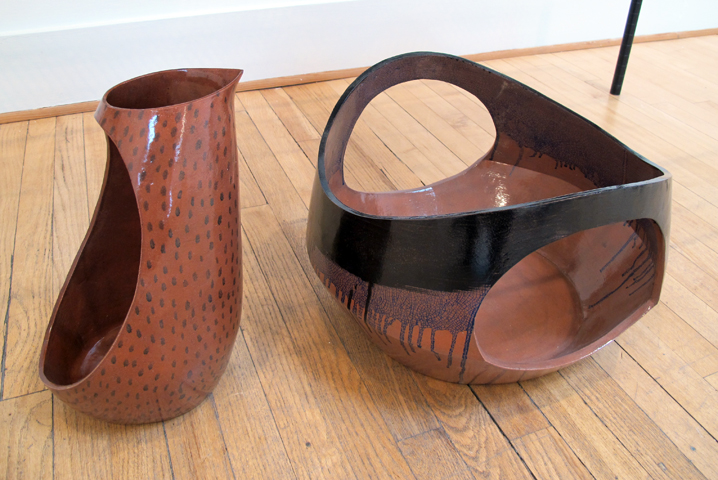review of Laith Karmo's "Laith Karmo: Potter", 8 November 2014 - 31 January 2015
Paul Kotula Projects
23255 Woodward Avenue
Ferndale, Michigan 48220-1361
With a couple of months’ perspective, time, writing, dictating to SIRI and rewriting, the process of writing about Laith Karmo’s work became more than I ever imagined. I shopped this writing to a few different outlets with initial interest, muted declination and thankful rejection. This text I am writing to convey the importance of Laith Karmo’s work. He tries, so I try and you should, too. There is an old saying, “communication is a two-way street.” I propose we meet each other half-way.
A few months ago, I was scrolling through my news feed on Instagram and came upon an image of Laith’s* work on a studio table- four wrapped garlands of white sage carefully placed upon a wide and low plate in our shared studio. I went to the studio that evening and saw the communication in play. That moment, like many moments I shared with Laith, lingered like incense in a still room. I viewed the installation as an offering and a sign of things to come...
Two days after seeing Laith’s Instagram photo, I continued to view his works in process and condensed his work to one word: generous. I tried turning the idea over and over, examining the various readings of the term, and its related iterations such as generosity, generousness and generously. The following are musings resulting from an intimate perspective as Laith’s studio mate.
Laith and I talk often about nearly every subject imaginable over a delicious salad, fruit plate or while simultaneously working in the studio. It does not always go deep and occasionally we talk about work and life. Laith’s art and life have always been inextricably linked. I saw him in the moments of ritual actions; in the studio or while cooking. For ceramists, there is always a ritual to our process as we prepare our clay and our body for the act of making. There are the repetitive actions of kneading or wedging, rolling, stacking and blending coils to create anew. Laith's work is bound to the ritual of giving, though it is not always how one might expect.
| figure 1 |

|
Laith Karmo. Spotted Vase, 2014. Terracotta. 14" x 8". Ocular Basket, 2014. Terracotta. 11.25" x 16" x 17". Photo courtesy Paul Kotula Gallery website. |
| |
figure 2 |

|
"Laith Karmo: Potter" (installation), 2014. Paul Kotula Gallery. Photo courtesy Paul Kotula Gallery website. |
For example, in one of his works, Spotted Vase, 2014, (fig. 1) the interior of a tall pitcher with dark-blue brush-spots gives to us in a way where we are only presented so generously by bowls. It is as if his work says "here have some," as in Vermeers's Milkmaid, 1657–1658. Then, in an instant, the work subverts such an idea when we realize the dysfunction of many of the vessels by their inability to hold water.
Laith’s works use his intuition as guidance to draw decisive lines with his bamboo knife, as if to give a nod to Henri Cartier-Bresson's Decisive Moment (Simon & Schuster, 1952) and stands in contrast to the pre-visualized world of the sketch book. The handles or painterly embellishments are “drawn” at a moment of heightened awareness, with the form in hand.
In a recent exhibition at Paul Kotula Projects in Ferndale called “Laith Karmo: Potter”, 8 November 2014 - 31 January 2015, (fig. 2) Karmo’s work progressed from the studio to the gallery. The visual world of the supermarket or general store becomes evident in the installation by the works displayed on Metro Shelving near or directly on the floor. Pots arrange as a constellation throughout the larger room of the project space with no hierarchy or ranking other than Karmo’s aesthetic inclinations.
The latest works presented by Karmo at Kotula Projects reminds me of Andy Warhol’s Paintings for Children, 1983, where the art hung for the convenience of gallery-goers’ children. While such a method appears energetic and to utilize play, it did not work as well in Paul Kotula’s space for many of Laith’s pieces. It works best for objects that offer plates or wide vessels, but many of the finely crafted aspects of some vessels were lost in lowness, most memorably a small, golden vessel on the right-side wall of the main gallery.
Likely for anyone visiting Japan, the offering and receiving of business cards is always with two hands and bowing as a simple, ritualized act to honor both giver and receiver. The business card ritual in Japan reminds me of the many vessels in Laith’s exhibition where two-handled clay "baskets" weave into the language of the work, like a poet-weaver spinning couplets. The evolution of utilitarian objects and the ways in which artists riff on archetypal forms such as a basket are nothing new. In Laith’s exhibition, however, I am struck by the question of why the artist chose the basket-form. Perhaps the answer lies in Laith’s own history. The shopping basket may seem a distant relative of the sweetgrass baskets of Low-Country Charleston, South Carolina, but the needs of those who use a basket are still the same: to gather, collect and carry. Laith grew up the son of a grocer in a culture of provisions like the many depots found on the Oregon Trail. For the purpose of this text, the definition of grocer or “provisionalist” is one who provides with food, drink or equipment, especially for a journey. “Laith Karmo: Potter” extends the grocer’s lineage where the works are the equipment for our long journey home.
*llllaith is Laith Karmo’s handle on Instagram |





